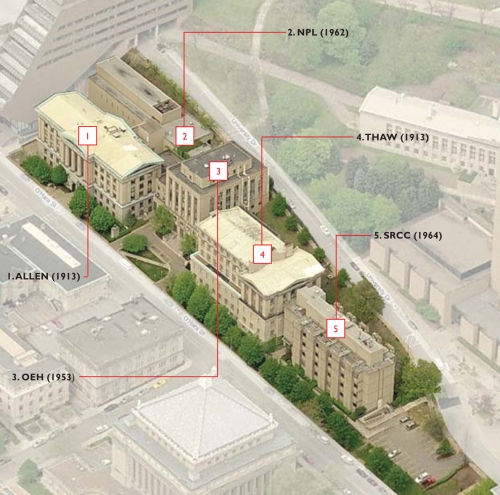Overview of the Oakland Campus Physics Complex

Allen Hall
Allen Hall is a Pittsburgh History and Landmarks Foundation Historic Landmark and the main building in the Physics and Astronomy complex. It is a six story building designed by J. H. Giesey and was dedicated on February 26, 1915, in a ceremony in which Richard B. Mellon and Andrew W. Mellon turned over the keys of the institute to University of Pittsburgh Chancellor Samuel McCormick.
Allen Hall is named for a former University of Pittsburgh Physics professor, Alex Allen, who arrived at Pitt in the 1930s and led a project for the construction of a cyclotron for producing radioactive isotopes for medical applications. This facility, called the Sarah Mellon Scaife Radiation Laboratory, was completed in 1946.
The facade at the entrance of this building has a plaque to honor Madame Curie, commemorating the 100th anniversary in 1967 of her birth, the conferring of an honorary degree in 1921, her visit to the plants of the Standard Chemical Company, its role as a major radium producer and in the making of the gram of radium presented to Marie Curie by President Warren G. Harding, and the role of Glenn Donald Kammer, a University of Pittsburgh graduate who supervised its production. The plaque was unveiled on September 20, 1969 by the Archbishop of Kraków, Poland, Cardinal Wojtyła, who in 1978 became Pope Jean Paul II.
Nuclear Physics Laboratory
The beginning of the University of Pittsburgh Nuclear Physics Laboratory dates to the late 1930s when Alex Allen came to the University of Pittsburgh as a professor of physics with the goal of building a cyclotron for producing radioactive isotopes for medical applications. He obtained a gift from the Scaife family for this purpose, with the facility called the Sarah Mellon Scaife Radiation Laboratory. In 1946 construction was completed with the cyclotron delivering internal beams of 15 MeV deuterons, 7.5 MeV protons and 30 MeV alpha particles that were used for the production of radioactive isotopes. Subsequently Allen's main efforts were directed at getting reliable external beam and designing a high-energy resolution system for determining with high precision the energies of reaction products. For this effort, Roger Bender from the University of Wisconsin was hired in about 1948, and was soon joined by two other Wisconsin alumni, Jim McGruer and John Cameron, and in the mid-50s Karl Quisenberry from the University of Minnesota. High-resolution studies of energy levels in light nuclei were completed with several Ph.D. theses resulting. This program was able to draw on theoretical support in the physics department, involving Professors Ed Gerjoy, Phil Stehle, and later Norman Austern, Elizabeth Baranger, and Sidney Meshkoff.
In 1962, a grant of $1.65 million was obtained from the National Science Foundation for the purchase of the world's first 3-stage Van De Graff accelerator, and a $1 million gift was obtained from the Sarah Mellon-Scaife foundation for a building to house it. Today, the Nuclear Physics Laboratory building houses specialized laboratories for a range of condensed matter experiment laboratories.
Old Engineering Hall
This building, constructed in 1953, housed the engineering departments until they moved across O'Hara Street in 1971. Today Old Engineering houses a number of laboratories, offices, and educational spaces for the Department of Physics and Astronomy.
Thaw Hall
Several department lecture halls, classrooms, and lecture demonstration equipment are housed in Thaw Hall. Built in 1913, Thaw Hall was one of the original buildings of the University of Pittsburgh's so-called Acropolis Plan, which called for classical-style buildings to be constructed on the steep hill behind the current buildings. The plan stalled due to costs, and campus development focus switched to the Lower Campus with the construction of the Cathedral of Learning beginning in 1928.
Allegheny Observatory
The Allegheny Observatory is an American astronomical research institution, and part of the Department of Physics and Astronomy at the University of Pittsburgh. The facility is listed on the National Register of Historical Places and is designated as a Pennsylvania state and Pittsburgh History and Landmarks Foundation historic landmark.
The observatory was founded on February 15, 1859, by a group of wealthy industrialists calling themselves the Allegheny Telescope Association. The observatory's initial purpose was for general public education as opposed to research, but by 1867 the revenues derived from this had receded. The facility was then donated to the University of Pittsburgh (at the time known as the Western University of Pennsylvania). The current building was constructed in 1905 in Pittsburgh's Riverview Park. The 30-inch Thaw Refractor was the third-largest telescope in the United States when it was installed in 1915. It is currently used for education of University of Pittsburgh students, public lectures and outreach programs, and an undergraduate-led research effort in extrasolar planet transit observations.
Google Map
Physics and Astronomy Department
100 Allen Hall